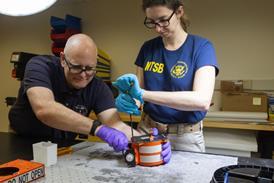NASA JET PROPULSION Laboratory (JPL) engineers at Pasadena, California have completed installation of key flight hardware aboard the Cassini spacecraft, which will be launched towards Saturn, by a Titan 4/Centaur booster in October 1997.
The craft's attitude- and articulation-control subsystem was integrated, together with the power and pyrotechnics subsystem, which controls the flow of electricity through 11km (7 miles) of cables on the craft. Tests of the Cassini's multiple-frequency radio system have been completed. Italy is providing the Cassini's antennae.
Other major milestones, have been the vibration testing, of the European Space Agency's Aerospatiale-built Huygens probe, which is destined to land on the Saturnian moon, Titan, and a 200min test firing, of one of the Cassini's two (primary and redundant) main engines, including the successful operation of JPL developed engine gimbal actuators.
The major firing of the primary engine will be a 90min burn, to place the Cassini/Huygens combination into orbit around Saturn in July 2004. The craft will reach Saturn, via two gravity-assist fly-bys of Venus (in April 1998 and June 1999), an Earth fly-by in August 1999 and one of Jupiter in December 2000. The total mission to 2008 will cost an estimated $3.5 billion, NASA says.
Russia says that it will launch a spacecraft to Mars on 16 November. The craft is scheduled enter an orbit around the planet in 1997 and to send four penetrators into the Martian soil at locations in the large desert plains of Arcadia and North Amazonia, as well as in the Utopia plain, which contains dried-up river channels.
Source: Flight International























